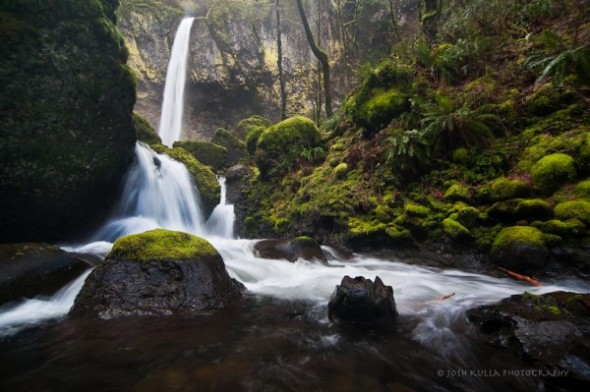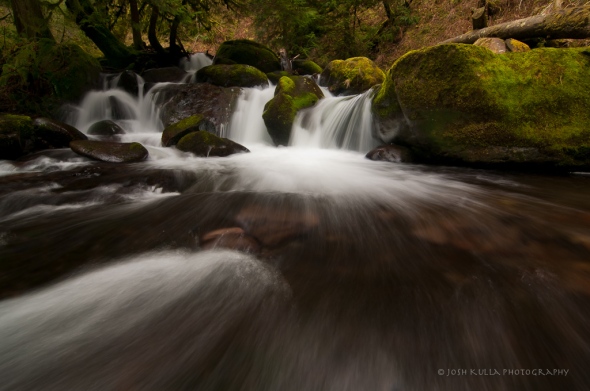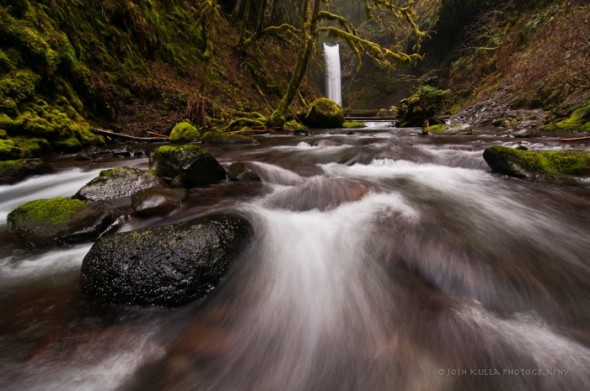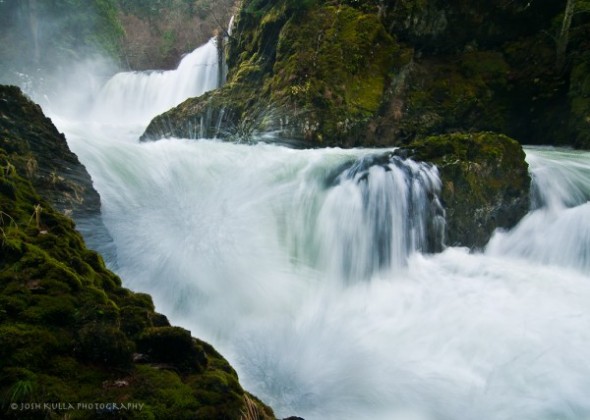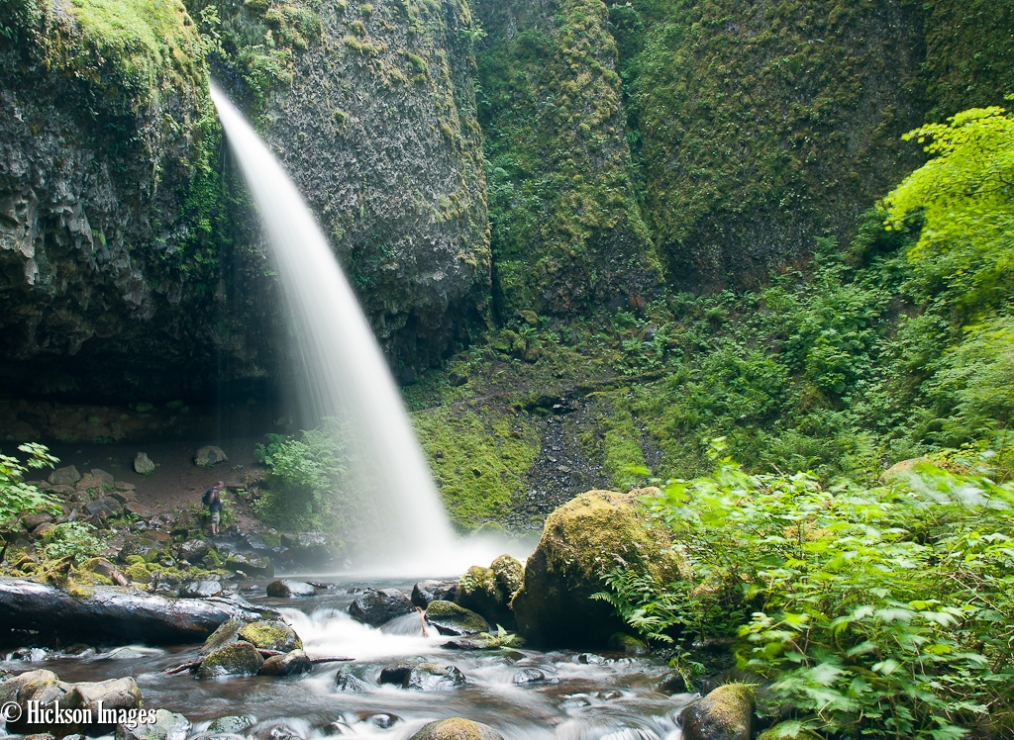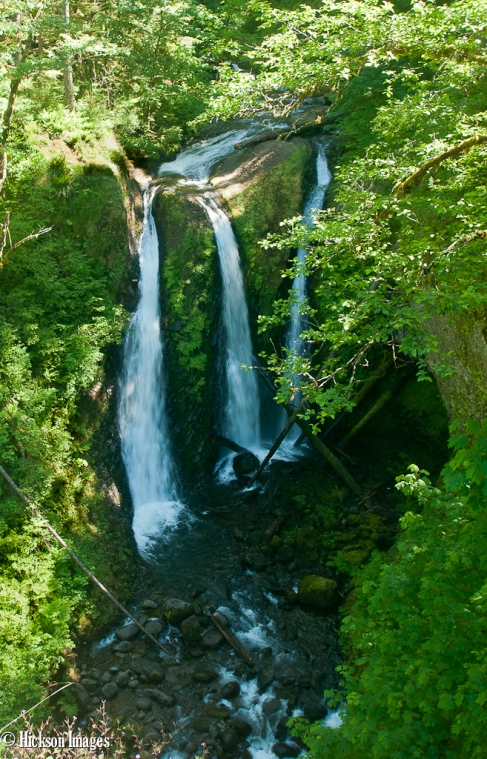Elowah Spring
 Elowah Falls in the Columbia River Gorge is one of the most easily accessible of the major waterfalls near the Portland metropolitan area. You still have to get your feet wet to take full advantage of this spot as a photographer, though, which is where things get really fun. On this day, though, I was kind of stuck for compositional ideas and ended making compromises that I didn’t like with regard to placing different elements in different spots. Plus, this waterfall always is a challenge to expose properly because of the tree cover shading the creek below this huge boulder to the left. That relative window into the amphitheater of basalt and lichen, though, is one of my favorite views in the entire Gorge and I never tire of seeing it.
Elowah Falls in the Columbia River Gorge is one of the most easily accessible of the major waterfalls near the Portland metropolitan area. You still have to get your feet wet to take full advantage of this spot as a photographer, though, which is where things get really fun. On this day, though, I was kind of stuck for compositional ideas and ended making compromises that I didn’t like with regard to placing different elements in different spots. Plus, this waterfall always is a challenge to expose properly because of the tree cover shading the creek below this huge boulder to the left. That relative window into the amphitheater of basalt and lichen, though, is one of my favorite views in the entire Gorge and I never tire of seeing it.
Thanks for viewing, your feedback is always encouraged and welcome.
The Rush of the Gorge
Does anyone else run out of interesting, yet descriptive names for landscape photos? This image shows Multnomah Creek just below Dutchman Falls. It can be found less than a half-mile from where Multnomah Falls pours 600 feet over a rock ledge to the Columbia River below, and it’s one of the most beautiful spots on the entire creek.
The three mini-cascades team up to form a powerful current that is actually pretty brisk when you’re standing in its midst. Friend and fellow photographer Gary Meyers and I enjoyed a recent morning on this creek and came away with a portable hard drive’s worth of nice images, thanks to the perfect shooting conditions. This past week has been prime waterfall shooting weather in Oregon, and I’d like to think we took full advantage of it.
Thanks for viewing!
Spring for some Weisendanger
Yesterday, I made my second outing this spring into the Columbia River Gorge. I paid a visit to Multnomah Creek, which feeds the world-famous Multnomah Falls before it plunges over 600 feet down to the Columbia River itself. Because of the that, the waterfalls above the main falls, such as it is, are often overlooked by photographers and hikers. But they are absolutely worth the visit, even if you don’t have a camera in hand.
In the photo above, Weisendanger Falls is shown in the background, with the onrushing creek coming straight at the viewer. Weisendanger is a 50-foot waterfall that pours into a beautiful little ampitheater, while just upstream sits the even taller Ecola Falls, which tumbles off a basalt ledge and around a sharp corner past the splash pool.
Downstream from Weisendanger, probably no less than another 200 yards, sits the multi-tiered Dutchman Falls. It’s one of the most scenic stretches of water that Oregon has to offer, and that’s saying something. In this shot, I played around with shutter speeds a little bit to get the detail in the water I was looking for. I used speeds ranging from 1/8 second to 15 seconds in an attempt to find as wide a range of looks as possible.
Chaos at Spirit Falls
For landscape photographers it’s often true that the more difficult it is to reach a destination, the more rewarding the images turn out to be. Spirit Falls in Skamania County, Washington, definitely falls into this category. With no real established trail, and a demanding hike down into the canyon carved out by the Little White Salmon River, it is hard on the knees but very much worth the effort.
This spot is a favorite of extreme kayakers, who like nothing more than to run the 35-foot waterfall before plunging downstream through a notorious section of Class 5 rapids known simply as Chaos. The beginning of this section is shown above earlier this month after a heavy rain, and it’s easy to see where the name came from. It’s mesmerizing to watch the river plunge, churn and spit streams of water in all directions. Capturing this required faster shutter speeds than I normally use for waterfalls, but the resulting explosions of water made for some pretty captivating images.
In the photo above, shot at f/8 and 1/8th of a second, it’s easy to almost feel the icy water about to drench the camera’s lens. That’s what happened, and I was pretty thankful for the handy rain cover over my D700. Shots like this made the 600 foot vertical climb back out of the canyon a bit easier to manage, and I’m definitely looking forward to returning here when the water level is a bit lower.
Fairy Falls on Labor Day
I woke up at dawn this morning and couldn’t sleep. So I threw my camera gear together, grabbed the tripod and headed up the Columbia River Gorge. I wasn’t quite sure where I was going to stop, but that turned out to be Wahkeena Falls and the trail above. I hiked to Fairy Falls, above, and a bit beyond, taking several hundred photos of this beauty, along with Wahkeena Creek and Little Necktie Falls.
Fairy Falls is one of the most photographed waterfalls in Oregon, despite being barely 25 feet tall. Its perfect fan shape and innumerable small cascades all combine to make it a photographic heaven, though. And the fact you can walk right up to the waterfall, touch it and experience barely any spray means you can shoot close up and get some interesting angles like the shot above. I’ve often found that including only part of a waterfall in the frame can produce very interesting photographs, and this was no exception. (20mm, f3.5 at ISO 200, 0.5 second exposure).
Slow Weisendanger Ahead
Weisendanger Falls can be found as one follows Multnomah Creek in the Columbia River Gorge. This half-mile stretch of the creek contains three significant waterfalls, all of which are amazingly photogenic in their own right. Weisendanger is the middle of those three, which also include Dutchman and Ecola Falls.
I’ve learned a lot about shooting waterfalls this summer from the amazingly skilled landscape photographers that inhabit Oregon. It’s not surprising our state is home to some of the world’s best shooters, including Darren White and Gary Randall, who constantly amaze me with the images they turn out. They are living representation of the fact that patience is key when it comes to landscapes. Their ability to wait for the right light, even it means sitting on an exposed, wet sand dune or mountainside for hours on end.
In the same vein, I’ve come through experimentation to find that most waterfalls and streams look fabulous when shot at exposures ranging very roughly between one-quarter of a second and two seconds in length. These are long-ish exposures to be sure. But in this case, I wanted to take advantage of the low water flow this time of year to make exposures of up to 30 seconds to see what resulted. The image above is a 20-second exposure at f.22, and it resulted in a very dream-like water surface that I actually find quite attractive because of the way it fills in some of the gaps in what would otherwise be a much darker foreground.
It’s an image that you cannot possibly see with the naked eye. And to me, one of the biggest attractions of photography is the ability to use a camera to create what hasn’t been seen before.
Fairy Falls, Columbia River Gorge
Fairy Falls in the Columbia River Gorge is one of the most heavily photographed spots in both the Gorge and Oregon as a whole. It’s a unique spot, that I found slightly strange because it was not quite as attractive in person as in the many photos I viewed prior to making the 1.3 mile hike this morning. It’s not that it’s a dump, far from it. It’s a beautiful, 20-foot waterfall with a unique pyramidal structure and a mellow water flow that makes it easy to get up close and shoot photographs. It might be the battered wooden walkway behind the camera and to the left. Or it could be the bench one passes as you walk up to the waterfall just above where it flows into Wahkeena Creek. Once I got home and viewed the photos I had taken of Fairy Falls, including the one above, a variation on one of the two main compositions this location offers, I knew my hunch had been right. The images I saw were more attractive than I remembered the location being in person. It wasn’t the light, which was too bright for my liking. But whatever it was, I’ve got some photos that are better than the ones stored away in my head.
Latourell Falls, Columbia River Gorge

If Latourell Falls were almost anywhere else in the world it probably would be a lot more well known.
It would certainly be a destination spot for hikers, photographers and more. But it has the misfortune of being a 249-foot tall waterfall situated just a few miles from Multnomah Falls, which at over 650 feet tall dwarfs the rest of the Columbia River Gorge waterfalls, of which there are dozens. It seems strange that a waterfall that looks like this can be relatively anonymous both locally and further afield.
I guess, though, all that just means Latourell Falls will never be overrun with tourists like Multnomah Falls can be during the summer. Thus it was that a fellow photographer and I were out chasing water photos the other morning in Washington, only to be driven out of Panther Creek by a thunderstorm and some intense lightning. So we ended up here, at Latourell Falls, with not a single other person in sight. (ISO 100, Tokina 11-16mm lens at 14mm, f/7.1 and a 0.4 second exposure)
Dutchman Falls, Columbia River Gorge

There are so many waterfalls in Oregon’s Columbia River Gorge, it often makes sense to combine one, two or many more destinations into a single hike. That’s what I did Friday morning at dawn on a stretch of Multnomah Creek containing three significant falls. And that’s not counting Multnomah Falls itself, which is by far the largest waterfall in Oregon with a drop in excess of 600 feet. At any rate, the first fall you’ll come to on Multnomah Creek prior to its final plunge to the Columbia River is Dutchman Falls, shown above. Or at least part of the three-stage waterfall is shown above. Because it is small and accessible, there are a wonderful variety of compositions available here and elsewhere on the creek. I spent three plus hours there Friday morning and ran out of time after the sun finally popped above the gorge walls and added too much contrast to continue with long exposures. The photo above was taken just before that point, with the sun adding nice side lighting to the basalt columns at camera left. This is one Columbia River Gorge spot I’m going to be heading back to in the future. (Tokina 11-16mm wide-angle lens at 11mm, ISO 100, f/11, 0.6 second exposure)
Ecola Falls, Columbia River Gorge

So, I’m changing the name of this blog to reflect the actual name I’m going to use professionally when I’m not on assignment for the newspaper or other publication. But I digress already. I went up Multnomah Creek this morning in the Columbia River Gorge in search of waterfalls and light and I found both. It was a little bit cloudy, which is perfect for waterfall photography, and it surprised me a little bit given how sunny and clear it’s been here in Oregon. It is mid-July, after all. Ecola Falls, shown above, was just one of the beautiful sights I found after a 1.7 mile hike to the top of Multnomah Falls and beyond. At peak flow, the spray is much more intense, I’m told. But here, the lower flow provides separate ribbons of water that really stand out in a photograph. Just another reason I love photographing the Gorge and its dozens of waterfalls in my spare time.
Gorge Waterfalls continued

It seems like every time I head out to a new waterfall this summer to shoot landscape images I find my latest favorite spot. That certainly was the case on July Fourth, as I headed to Elowah Falls in Oregon’s Columbia River Gorge to shoot some early morning waterfall and stream photos. This place had the best boulders I’ve seen in terms of moss-covered caps. They were incredible to climb, lay and sit on while I took photos. Spongy beds of dry comfort for my tripod and myself, unspoiled by any other voices or footsteps. It pays to get up early.
This was probably my favorite vantage point of the day, despite the fact my attempted framing of the main falls with hanging branches was ruined by overzealous greenery. Nonetheless, when the leaves come down in the fall, I will be back to enjoy the view, and probably long before that. (Tokina 11-16mm f/2.8 lens, f5.6, 1/5 second exposure at ISO 200.)
Columbia River Gorge Waterfalls 8

Bridal Veil Falls in Oregon’s Columbia River Gorge is yet another easily accessible and often photographed gem along the Historic Columbia River Highway that parallels Interstate 84. More than most waterfalls, it requires soft light to really bring out its best features. The contrast in light is extreme at times between the upper falls, which is exposed to daylight, and the pool where the falls continues its trip downhill to the river. Fortunately, this morning was overcast and provided a nice warm hue to the scenes for long exposures, including the one above. (Tokina 11-16mm wide angle, 100 ISO, f/11, 0.8 second exposure).
Columbia River Gorge waterfalls 7
Here’s a horizontal view of Ponytail Falls in the Columbia River Gorge. I shot probably 1,100 or more photos in the gorge during the two weeks I was on vacation, and I am really enjoying being able to post a steady stream of interesting material here. This waterfall actually presents a nice photographic challenge, as it is easily accessible by day hikers, hence heavily photographed from the surrounding trails and other obvious vantage points. Admittedly, even wading into the stream as I did here is not difficult for anyone so inclined. But at least it gives a somewhat different perspective than someone who is only paying attention to walking behind the waterfall, beautiful as that can be. I guess I’m going to be getting up pretty early some mornings this summer, otherwise I won’t be able to find time to realistically continue with my Gorge series of landscapes, which is rapidly turning into my seasonal photo project. Does anyone else find that a single shoot ever turns into an ongoing obsession when you’re behind the camera? Don’t worry, it’s probably a good thing as a photographer, so I’ll go with it.
Columbia River Gorge Waterfalls 6

Wahclella Falls in Oregon’s Columbia River Gorge is located in a natural rock amphitheater carved out of a series of overlapping basaltic lava flows dating back millions of years. For photographers, this forever damp, green landscape now makes an ideal setting for making beautiful images. The closest active volcano is Mt. St. Helens on the other side of the Columbia River, and the biggest geologic hazard is not lava, but landslides.
The shot above was taken from a rock outcrop well above the water using a Tokina 11-16mm wide angle zoom lens at f/14 with a 1.6 second exposure at ISO 100. That’s about as long of an exposure as I like to make for water unless I’m really going after a smooth, silky look. Here, I’m just trying to give a sense of motion, rather than a new rendering of Fantasia, and I think the water exploding into streaks at the bottom of the falls does just that.
Columbia River Gorge Waterfalls 5
Here’s a photo taken last week of the Triple Falls in the Columbia River Gorge here in Oregon. Each of these three waterfalls feature a drop of over 100 feet, although it’s difficult to gauge the scale from this viewpoint, which is virtually the only place you can get a good look at the falls without rappelling down ridiculously steep cliffs. I definitely did not time this stop properly, as the midday sun and its shadows make difficult the type of long exposures I was looking to create. At other times during the same day, however, the sun remained hidden for the type of diffusion that makes for lovely water photographs. That’s Oregon, though. Unpredictable.
Columbia River Gorge Waterfalls 4

With one day left of my stay-cation, I went a bit further east in Oregon’s Columbia River Gorge today and stopped at the Wahclella Trailhead, which begins a fairly easy one mile hike to Wahclella Falls, shown above. The natural amphitheatre where the water pools before continuing its journey downhill to the Columbia River is several hundred feet deep and provides a beautiful setting for water photography and other fun. I sank my tripod in the stream and continued shooting until I came up with something like the image here (Nikkor 20-35mm wide-angle zoom, ISO 100, f/14 and a 1.6 second exposure). Edit: I also need to mention that I set my variable ND filter to cut out roughly two stops of light, allowing the slower shutter speed. I can’t do this type of photo without the neutral density filter, although a circular polarizing filter also serves the same purpose under slightly darker conditions, while also cutting into any glare from the surface of the water.
I’ve been lucky the past two weeks in being able to explore the Columbia River Gorge more thoroughly than I normally am able to manage. It’s been great for my photography, which normally covers a wide range of photojournalist subjects, but not normally landscapes or waterfalls. And tomorrow I get to go back to that grind, albeit with better command of slower exposures.
Columbia River Gorge 6

The waterfalls of the Columbia River Gorge are revered by photographers around the world, and for good reason. But the streams that feed them and flow on to the Columbia River can be just as interesting to photograph once you get down and close to the water and examine the detail. The stream pictured here flows away from Wahkeena Falls and on to the mighty Columbia, passing under bridges, around rock formations and under the vegetation along the way. The flowers provide detail in this frame, while the bridge in the upper left corner gives context and scale to the overall scene. If I could, I’d probably spend 10 hours a day shooting photos in the Gorge. But that would mean missing out on a lot of other fascinating photography, as well as rock ‘n roll music, so it’s not a long-term option, unfortunately. (Nikkor 20-35mm wide angle zoom, ISO 200, f/16, 1.3 second exposure with a circular polarizing filter.)
Columbia River Gorge waterfalls 3
This waterfall photo was taken last week at Bridal Veil Falls in the Columbia River Gorge as part of am ongoing waterfall series that I’m doing while on vacation from my regular photojournalism duties. Taken at sunset, I was able in this image to capture some interesting lens flare coming from the right side of the frame. This is one of the more accessible waterfalls in the Gorge and you’re likely to encounter at least one or more photographers while visiting. And looking at this waterfall, it’s easy to see both how it earned its name, as well as why it’s a popular destination for hikers, nature enthusiasts and photographers.
Interestingly, it’s a simple matter to overlook the fact the old scenic highway passes right over the top of the falls. The way the road is situated, you can’t see the waterfall even if you’re looking for it. After spending several evenings last week in the Gorge I seriously wish I was on vacation all the time. (Nikon D300s, Tokina 11-16mm lens with circular polarizing filter, ISO 100, f/11, 0.8 second exposure.)
Columbia River Gorge waterfalls 2

I’ve shot a boatload of compelling waterfall and water photography images during the past week in the Columbia River Gorge. On Saturday, I hiked up Forest Service Trail 424 to the Triple Falls viewpoint, as well as the Ponytail Falls trail. Upper Oneonta Falls, shown above, is found on the latter trail and is an easy hike from the historic Columbia River Gorge highway. The next time I find myself here, I’ll likely scramble down the hillside to the stream below for a different angle. But this view of the top of the rugged Oneonta Gorge still forces one to sit and stare for a while. (Nikkor 20-35mm wide angle zoom, ISO 200, f.8, 1 second exposure.)
Columbia River Gorge waterfalls

Oregon’s Columbia River Gorge has something like 75 waterfalls that are accessible to hikers, many of which are not surprisingly landscape photographers. Some of the hikes are relatively easy, while others require a bit more effort. Ponytail Falls, above, is one of the former, with roughly a two-mile hike involved. If you stop there, though, you’re cheating yourself out of several other nearby gems. Some which I’ve visited recently inclue the Triple Falls, Horsetail Falls and several others in the impressive Oneonta Gorge, which is now targeted for my next trip up the Columbia River, hopefully in the coming week.
The shot above was taken with a 20-35mm wide angle zoom lens at f.13 with a one-second exposure. Because of the nicely diffused light, I only used a one-stop ND filter, although that probably wasn’t even needed. I like this image because it nicely shows the old basalt flow above the waterfall. Those Columbia River flood basalts erupted across the Northwest from 14-17 million years ago and covered over 63,000 square miles in what now is Oregon, Washington, Idaho and Nevada. This includes the entirety of what became the Columbia River Gorge. The soaring basalt columns can be seen as you travel along Interstate 84 on either side of the Columbia River, testament to the volcanic nature of our region.
As always, I’m open to comments and criticism, so if anyone has anything along those lines, please feel free to chime in. Thanks!
Columbia River Gorge 5

Wahkeena Falls in Oregon’s Columbia River Gorge has provided me with a wealth of photographs this week. One result of this is that I cannot decide which I like better; the more distant images showing waterfalls or the many shots I’ve taken from the middle of the streams carrying water away from those waterfalls. I shot the creek above from numerous angles and perspectives, and in many of the photos I felt like the rocks resembled the heads of animals. This helped guide me in framing certain images, including this one, a 1.3 second exposure taken with a Tokina 11-16mm lens and circular polarizing filter at ISO 200 and f.11.
Columbia River Gorge Part 4

It’s been nice having a little bit of extra time to explore the Columbia River Gorge and its dozens of waterfalls this week. The photo here was taken at one of the upper levels of Shepperd’s Dell Falls just west of the more well-known Multnomah Falls. I used a polarizing filter with my Tokina 11-16mm wide-angle lens and shot this at 4/10 of a second at f.8 and 200 ISO, not that it’s all that important. The scenery here, as it is throughout the Gorge, is incredibly lush and probably familiar only to natives of somewhere like New Zealand. Which is probably why Peter Jackson chose that location to film Lord of the Rings. But that’s another conversation…
Columbia River Gorge Part 3
Here’s one more photo from Monday’s trip to the Columbia River Gorge and Wahkeena Falls. This is a slightly longer exposure than the previous two images at around 2.5 seconds at f.16 using the same Tokina 11-16mm lens and a variable neutral density filter. I also find it interesting that an extra one to 1.6 seconds of exposure gives a distinctly different look than the other images, with the water appearing much smoother and with less of a sense of motion. So the next time anyone tells you an extra second doesn’t make a difference, tell them water photography begs to differ.
Columbia River Gorge afternoon revisited
Here’s a another shot from the Columbia River Gorge near Wahkeena Falls taken yesterday when the weather still was cooperating. The waterfall itself was tough to shoot for various reasons, which meant images taken downstream from the waterfall turned out much nicer. I’ll be heading back this week for another go at the various waterfalls in the Gorge, which contains dozens of them between Portland and Hood River.
This shot was taken by stepping into the stream with my tripod and making a simple 1.6-second exposure with a Tokina 11-16mm lens at f.11. I used to think I liked the Oregon Coast more for its gorgeous landscapes. But the Gorge, for me, has supplanted the coast in that regard and I can’t seem to get enough of it. Great stuff.
